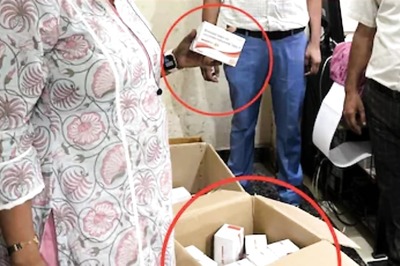
views
In a push to promote inclusivity in the armed forces, Defence Minister Rajnath Singh has approved a proposal that entitles women soldiers, sailors and air warriors to the same leave terms as female officers in the three services.
The move, a part of Narendra Modi’s government push for inclusivity in armed forces, will improve work conditions for women in the military as it will help them balance their professional and family lives in a better manner. This covers maternity, childcare and child adoption leaves.
As women’s participation has increased in all security forces, including the police and paramilitary, the Modi government has been keeping pace with ensuring their all-round welfare. The Ministry of Defence statement said, “The extension of leave rules will go a long way in dealing with women-specific family and social issues relevant to the armed forces. This measure is going to improve the work conditions of women in the military and aid them to balance the spheres of professional and family life in a better manner”.
What Changes with the Move
Women officers at present are entitled to get maternity leave of 180 days with full pay for each child, subject to a maximum of two children. Childcare leave of 360 days is granted in total service career (subject to the child being less than 18 years of age). Similarly, women who adopt a child below one year of age are entitled to 180 leaves.
But uniformity in leaves had remained an issue as the services started inducting more and more women across ranks below officer (PBOR) cadre for the first time under the Agnipath scheme. While the navy has already begun recruiting women under the scheme, the air force and the army are preparing to do so as well. Now that all women soldiers are entitled to the same set of leave policies, more women are likely to find incentive in joining the armed forces and helping make India secure.
“The extension of leave rules will go a long way in dealing with women-specific family and social issues relevant to the armed forces,” the ministry statement said. “This measure is going to improve the work conditions of women in the military and aid them to balance the spheres of professional and family life in a better manner,” it said.
Empowering Women in the Indian Armed Forces
Nari Shakti dominated the 74th Republic Day parade this year as women officers led the marching contingents of the armed forces, CRPF, Akash missile system and Army’s Daredevil team. Additionally, the Modi government has opened the doors of the National Defence Academy to recruit women.
557 women officers have received permanent commission in the Army, after the Centre in 2018 decided to allow women officers in India’s armed forces to take up permanent commission after a Short Service Commission stint. Five women officers have been promoted to the rank of colonel, usually a rank that very few SSC officers achieve during their limited service period.
For the first time, 83 women jawans were appointed to the Military Police Corps of the Army. India also saw Captain Abhilasha Barak becoming the first Indian woman combat aviator in history.
Front-line combat roles had been off limits for women until Modi government disrupted that status quo back in 2015. In April this year, the Modi government also approved the Indian Army’s decision to induct woman officers in the Regiment of Artillery.
Measures to Ensure Parity
Several measures have been introduced across all three branches of service to bring parity in service conditions and opportunities:
Indian Army: At present, the women are being commissioned in the Indian Army in ten streams namely Corps of Engineers, Corps of Signals, Army Air Defence, Army Service Corps, Army Ordnance Corps, Corp of Electronics and Mechanical Engineers, Army Aviation Corps, Intelligence Corps, Judge Advocate General Branch and Army Education Corps in addition to the Armed Forces Medical Services as Doctors and Military Nurses which is a women-only entry. Currently, over 7000 women are serving in the Indian Army.
Indian Air Force: By September 2020, there were 1,875 female officers in various roles, including combat and support. In 2015, combat roles for women as fighter pilots were opened and in May 2019, Bhawana Kanth became the first woman fighter pilot qualified for combat missions.
In September this year, the Air Chief had announced that all branches of IAF now have women officers, making it a ‘gender agnostic’ force. IAF has also been modernising facilities to accommodate a growing number of women personnel, and has launched DISHA cells to encourage more women to join its ranks.
Indian Navy: Indian Navy has crucially decided to grant ship duties women specialist Naval Air Operations officers. Women officers are also now being actively inducted as pilots of Remotely Piloted Aircraft (RPA). More woman officers are getting deputed on overseas assignments as part of Mobile Training Teams and other foreign cooperation engagements.
The strength of women officers in the Indian Navy as of March 2023, is 748 including Medical and Dental officers. In December 2019, Sub-lieutenant Shubhangi Swaroop made history by becoming the first woman pilot for the Indian Navy, with a role in flying the Dornier 228 surveillance aircraft.
















Comments
0 comment